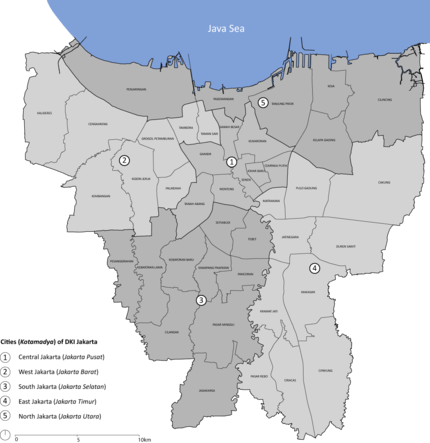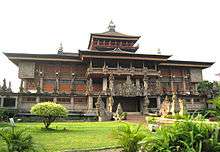Jakarta
| Jakarta | |||
|---|---|---|---|
| Special Capital Region | |||
| Special Capital Region of Jakarta Daerah Khusus Ibu Kota Jakarta | |||
|
(From top, left to right): Jakarta Old Town, Hotel Indonesia Roundabout, Jakarta Skyline, Gelora Bung Karno Stadium, Taman Mini Indonesia Indah, Monumen Nasional, Merdeka Palace, Istiqlal Mosque and Jakarta Cathedral | |||
| |||
| Nickname(s): The Big Durian,[1][2] J-Town[3] | |||
|
Motto: Jaya Raya (Sanskrit) (meaning: Victorious and great) | |||
.svg.png) Location of Jakarta in Indonesia | |||
| Coordinates: 6°12′S 106°49′E / 6.200°S 106.817°ECoordinates: 6°12′S 106°49′E / 6.200°S 106.817°E | |||
| Country | Indonesia | ||
| Government | |||
| • Type | Special administrative area | ||
| • Governor | Basuki Tjahaja Purnama[4] | ||
| • Vice Governor | Djarot Saiful Hidayat | ||
| Area | |||
| • Special Capital Region | 661.5 km2 (255.4 sq mi) | ||
| • Metro | 17,132 km2 (6,615 sq mi) | ||
| Area rank | 33rd | ||
| Elevation | 8 m (26 ft) | ||
| Population (2010 census) | |||
| • Special Capital Region | 9,607,787 | ||
| • Rank |
6th (province) 1st (city) | ||
| • Metro | 30,214,303 | ||
| Demonym(s) | Jakartan, Indonesian: warga Jakarta | ||
| Time zone | WIB (UTC+7) | ||
| Area code(s) | +62 21 | ||
| Vehicle registration | B | ||
| HDI |
| ||
| HDI rank | 1st (2015) | ||
| Website | jakarta.go.id | ||
| Jakarta is not part of any province, it is controlled directly by the national government and is designated as the Special Capital Region | |||
Jakarta /dʒəˈkɑːrtə/,[note 1] officially the Special Capital Region of Jakarta, is the capital and most populous city of the Republic of Indonesia.
Located on the northwest coast of the world's most populous island of Java, Jakarta is the country's economic, cultural and political center, with a population of 10,075,310 as of 2014.[5][6] The official metropolitan area, known as Jabodetabek (a name formed by combining the initial syllables of Jakarta, Bogor, Depok, Tangerang and Bekasi), is the second largest in the world, yet the metropolis' suburbs still continue beyond it. Its unofficial built-up (metropolitan) area covers Bogor, Tangerang, Bekasi, Karawang, Serang, Purwakarta, Sukabumi and Subang regencies (123 districts), also including Tangerang, Bekasi, Tangerang Selatan, Depok, Serang and Cilegon Municipalities, which in total were home to 30,214,303 inhabitants as of 2010 census.[7]
Established in the fourth century as Sunda Kelapa, the city became an important trading port for the Kingdom of Sunda. As Batavia, it became the de facto capital of the Dutch East Indies. After the country's declaration of independence in 1945, the city—then called Djakarta—retained its status as capital of Indonesia. The city is currently the seat of the ASEAN Secretariat as well as important financial institutions such as the Bank of Indonesia, the Indonesia Stock Exchange, and the corporate headquarters of numerous Indonesian companies and multinational corporations. Jakarta's business opportunities, as well as its potential to offer a higher standard of living, attract migrants from all over Indonesia, making the city a melting pot of many communities and cultures.[8]
Jakarta is listed as an alpha-global city in the 2012 Globalization and World Cities Study Group and Network (GaWC) research.[9] Based on the global metro monitor by the Brookings Institution, in 2014, economic growth in Jakarta ranked 34th among the world's 200 largest cities.[10] Jakarta has grown more rapidly than Kuala Lumpur, Beijing, and Bangkok.[11]
Names and etymology
Jakarta has been home to multiple settlements along with their respective names: Sunda Kelapa (397–1527), Jayakarta (1527–1619), Batavia (1619–1942, 1946-49), Djakarta (1942-46, 1949–1972), and Jakarta (1972–present).
Its current name derives from the word Jayakarta. The origins of this word can be traced to the Old Javanese and ultimately to the Sanskrit language. "Jayakarta" translates as "victorious deed", "complete act", or "complete victory".
Jakarta is nicknamed the Big Durian, the thorny strongly-odoured fruit native to the region,[1] as the city is seen as the Indonesian equivalent of the U.S. city of New York (the Big Apple).[12] In the colonial era, the city was also known as Koningin van het Oosten (Queen of the Orient), initially in the 17th century for the urban beauty of downtown Batavia's canals, mansions and ordered city layout.[13] After expanding to the south in the 19th century, this nickname came to be more associated with the suburbs (e.g. Menteng and the area around Merdeka Square), with their wide lanes, many green spaces and villas.[14]
History
Pre-colonial era
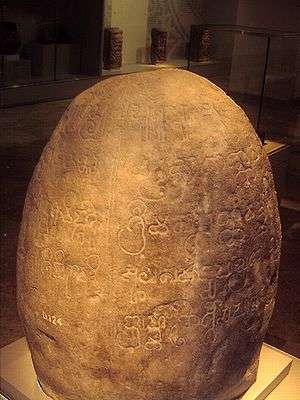
The area in and around modern Jakarta was part of the fourth century Sundanese kingdom of Tarumanagara, one of the oldest Hindu kingdoms in Indonesia.[15] Following the decline of Tarumanagara, its territories, including the Jakarta area, became part of the Hindu Kingdom of Sunda. From 7th to early 13th century port of Sunda was within the sphere of influence of the Srivijaya maritime empire. According to the Chinese source, Chu-fan-chi, written circa 1225, Chou Ju-kua reported in the early 13th century Srivijaya still ruled Sumatra, the Malay peninsula and western Java (Sunda). The source reports the port of Sunda as strategic and thriving, pepper from Sunda being among the best in quality. The people worked in agriculture and their houses were built on wooden piles.[16] The harbour area became known as Sunda Kelapa (Sundanese: ᮞᮥᮔ᮪ᮓ ᮊᮜᮕ) and by the fourteenth century, it was a major trading port for Sunda kingdom.

The first European fleet, four Portuguese ships from Malacca, arrived in 1513 when the Portuguese were looking for a route for spices.[17] The Hindu Kingdom of Sunda made an alliance treaty with Portugal by allowing the Portuguese to build a port in 1522 to defend against the rising power of the Islamic Sultanate of Demak from central Java.[18] In 1527, Fatahillah, a Javanese general from Demak attacked and conquered Sunda Kelapa, driving out the Portuguese. Sunda Kelapa was renamed Jayakarta,[18] and became a fiefdom of the Sultanate of Banten which became a major Southeast Asia trading centre.
Through the relationship with Prince Jayawikarta from the Sultanate of Banten, Dutch ships arrived in Jayakarta in 1596. In 1602, the English East India Company's first voyage, commanded by Sir James Lancaster, arrived in Aceh and sailed on to Banten where they were allowed to build a trading post. This site became the centre of English trade in Indonesia until 1682.[19]
Jayawikarta is thought to have made trading connections with the English merchants, rivals of the Dutch, by allowing them to build houses directly across from the Dutch buildings in 1615.[20]
Colonial era
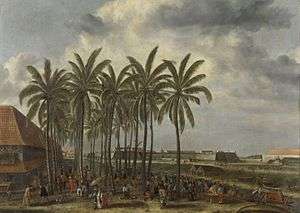
When relations between Prince Jayawikarta and the Dutch deteriorated, Jayawikarta's soldiers attacked the Dutch fortress. Prince Jayawikarta's army and the English were defeated by the Dutch, in part owing to the timely arrival of Jan Pieterszoon Coen (J.P. Coen). The Dutch burned the English fort, and forced the English to retreat on their ships. The victory consolidated Dutch power and in 1619 they renamed the city Batavia.
Commercial opportunities in the capital of the Dutch colony attracted Indonesian and especially Chinese and Arab immigrants. This sudden population increase created burdens on the city. Tensions grew as the colonial government tried to restrict Chinese migration through deportations. Following a revolt, 5,000 Chinese were massacred by the Dutch and natives on 9 October 1740 and the following year, Chinese inhabitants were moved to Glodok outside the city walls.[21] At the beginning of the nineteenth century, around 400 Arabs and Moors lived in Batavia, a number which changed little during the following decades. Among the commodities traded, fabrics, especially imported cotton, batik and clothing occupied by Arab communities.[22]

The city began to expand further south as epidemics in 1835 and 1870 caused more people to move away from the port. The Koningsplein, now Merdeka Square was completed in 1818, the housing park of Menteng was started in 1913,[23] and Kebayoran Baru was the last Dutch-built residential area.[21] By 1930 Batavia had more than 500,000 inhabitants,[24] including 37,067 Europeans.[25]
After World War II, the city of Batavia was renamed "Jakarta" (short form of Jayakarta) by the Indonesian nationalists after achieving independence from the Dutch in 1946.[26]
Independence era

Following World War II, Indonesian Republicans withdrew from Allied-occupied Jakarta during their fight for Indonesian independence and established their capital in Yogyakarta. In 1950, once independence was secured, Jakarta was once again made the national capital.[21] Indonesia's founding president, Sukarno, envisaged Jakarta as a great international city, and instigated large government-funded projects with openly nationalistic and modernist architecture.[27][28] Projects included a clover-leaf highway, a major boulevard (Jalan MH Thamrin-Sudirman), monuments such as The National Monument, Hotel Indonesia, a shopping centre, and a new parliament building. In October 1965, Jakarta was the site of an abortive coup attempt in which 6 top generals were killed, precipitating a violent anti-communist purge in which half-a million people were killed, including many ethnic Chinese,[29] and the beginning of Suharto's New Order. A monument stands where the generals' bodies were dumped.

In 1966, Jakarta was declared a "special capital region" (daerah khusus ibukota), thus gaining a status approximately equivalent to that of a province.[30] Lieutenant General Ali Sadikin served as Governor from the mid-1960s commencement of the "New Order" through to 1977; he rehabilitated roads and bridges, encouraged the arts, built several hospitals, and a large number of new schools. He also cleared out slum dwellers for new development projects—some for the benefit of the Suharto family[31][32]—and tried to eliminate rickshaws and ban street vendors. He began control of migration to the city to stem overcrowding and poverty.[33] Foreign investment contributed to a real estate boom which changed the face of the city.[34]
The boom ended with the 1997/98 East Asian Economic crisis putting Jakarta at the centre of violence, protest, and political maneuvering. After 32 years in power, support for President Suharto began to wane. Tensions reached a peak in when four students were shot dead at Trisakti University by security forces; four days of riots and violence ensued that killed an estimated 1,200, and destroyed or damaged 6,000 buildings.[35] Much of the rioting targeted Chinese Indonesians.[36] Suharto resigned as president, and Jakarta has remained the focal point of democratic change in Indonesia.[37] Jemaah Islamiah-connected bombings occurred almost annually in the city between 2000 and 2005,[21] with another bombing in 2009.[38]
Administration
Administrative divisions of Jakarta
Jakarta is administratively equal to a province with special status as the capital of Indonesia. It has a governor (instead of a mayor). As a province, the official name of Jakarta is Daerah Khusus Ibukota Jakarta ("Special Capital City District of Jakarta"), which in Indonesian is abbreviated to DKI Jakarta.
Jakarta consists of five kota administratif (administrative cities/municipalities), each headed by a mayor – and a kabupaten administratif (administrative regency) headed by a bupati (regent). Unlike other cities and regencies in Indonesia where the mayor or regent are elected by the people, Jakarta's mayors and regent are chosen by the Governor of Jakarta.
The administrative cities/municipalities of Jakarta are:
- Central Jakarta (Jakarta Pusat) is Jakarta's smallest city and home to most of Jakarta's administrative and political centre. It is characterised by large parks and Dutch colonial buildings. Landmarks include the National Monument (Monas), the Istiqlal Mosque, Jakarta, the Jakarta Cathedral, and museums.[39]
- West Jakarta (Jakarta Barat) has the highest concentration of small-scale industries in Jakarta. The area includes Jakarta's Chinatown and Dutch colonial landmarks such as the Chinese Langgam building and Toko Merah. West Jakarta contains part of Jakarta Old Town.[40]
- South Jakarta (Jakarta Selatan), originally planned as a satellite city, is now the location of large upscale shopping centres and affluent residential areas. Jakarta Selatan functions as Jakarta's ground water buffer,[41] but recently the green belt areas are threatened by new developments. Much of the CBD area of Jakarta is concentrated in Setia Budi, South Jakarta, bordering the Tanah Abang/Sudirman area of Central Jakarta.
- East Jakarta (Jakarta Timur) territory is characterised by several industrial sectors erected in this city.[42] Also located in East Jakarta are Taman Mini Indonesia Indah and Halim Perdanakusuma International Airport.
- North Jakarta (Jakarta Utara) is the only city in Jakarta that is bounded by the sea (Java Sea). It is the location of the Tanjung Priok. Large-scale and medium-scale industries are concentrated in North Jakarta. North Jakarta contains part of Jakarta Old Town, formerly known as Batavia since the 17th century, and was a centre of VOC trade activity in Dutch East Indies. Also located in North Jakarta is Ancol Dreamland (Taman Impian Jaya Ancol), currently the largest integrated tourism area in South East Asia.[43]
The only administrative regency (kabupaten) of Jakarta is:
- Thousand Islands (Kepulauan Seribu), formerly a district within the city of North Jakarta, is a collection of 105 small islands located on the Java Sea. It has a high conservation value because of its unique and special ecosystems. Marine tourism, such as diving, water bicycle, and wind surfing, is the most important touristic activity in this territory. The main mode of transportation between the islands are speed boats or small ferries.[44]
| City/Regency | Area (km2) | Total population (2010 Census) | Total population (2014)[5] | Population Density (per km2) in 2010 |
Population Density (per km2) in 2014 |
|---|---|---|---|---|---|
| South Jakarta (Jakarta Selatan) | 141.27 | 2,057,080 | 2,164,070 | 14,561 | 15,319 |
| East Jakarta (Jakarta Timur) | 188.03 | 2,687,027 | 2,817,994 | 14,290 | 14,987 |
| Central Jakarta (Jakarta Pusat) | 48.13 | 898,883 | 910,381 | 18,676 | 18,915 |
| West Jakarta (Jakarta Barat) | 129.54 | 2,278,825 | 2,430,410 | 17,592 | 18,762 |
| North Jakarta (Jakarta Utara) | 146.66 | 1,645,312 | 1,729,444 | 11,219 | 11,792 |
| Thousand Islands (Kepulauan Seribu) | 8.7 | 21,071 | 23,011 | 2,422 | 2,645 |
Government
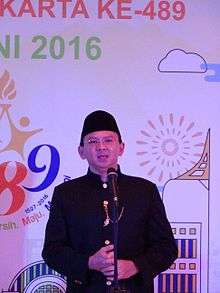
In September 1945, the government of Jakarta City was changed from the Japanese Jakarta Special City (ジャカルタ特別市 Jakaruta tokubetsu-shi) into the Jakarta National Administration. This first government was held by a mayor until the end of 1960, when the office was changed to that of a governor. The last mayor of Jakarta was Sudiro, until he was replaced by Dr Sumarno as governor of the province (as the city had now become).
In 1974, Based on the Act No. 5 of 1974 relating to the Fundamentals of Regional Government, Jakarta was confirmed as the capital of Indonesia and one of Indonesia's (then) 26 provinces.[45]
In August 2007, Jakarta held its first ever election to choose a governor, whereas previously the city's governors were appointed by the local house of representatives. The poll is part of a country-wide decentralisation drive, allowing for direct local elections in several areas.[46]
Municipal finances
The ability of the regional government to respond to the many problems of Jakarta is constrained by extremely limited finances. In 2013 the total budget available to the Jakarta regional government was approved at around Rp 50 trillion (about $US 5.2 billion), equivalent to around $US 380 per citizen. Priority areas of spending were listed as education, transport, flood control measures, environment programs, and various types of social spending (such as health and housing).[47]
The Jakarta provincial government, like all other provincial governments in Indonesia, relies on transfers from the central government for the bulk of budget income. Local (non-central government) sources of revenue are incomes from various taxes such as vehicle ownership and vehicle transfer fees and so on.[48]
In recent years, the Jakarta provincial government has consistently run a surplus of between 15–20% of total planned spending, largely because of delays in procurement procedures and other inefficiencies in the spending process.[49] Regular underspending is a matter of frequent public comment but the legal and administrative blockages that cause the underspending problem seem very difficult to overcome.[50]
| Year | Revenue | Expenditure |
|---|---|---|
| 2007 Actual | 18.7 | 18.7 |
| 2008 Actual | 32.9 | 16.4 |
| 2009 Actual | 23.7 | 19.6 |
| 2010 Actual | 26.8 | 21.6 |
| 2011 Actual | 31.8 | 31.7 |
| 2012 Actual | 41.4 | 41.4 |
Indonesian Statistics Bureau: Jakarta in Figures[51]
Geography and climate
Geography
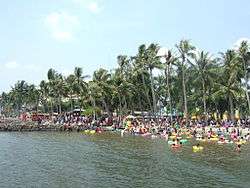
Jakarta is located on the northwest coast of Java, at the mouth of the Ciliwung River on Jakarta Bay, which is an inlet of the Java Sea. It is one of the only two Asian capital cities which located on southern hemisphere (another one is Dili, capital of Timor Leste). Officially, the area of the Jakarta Special District is 662 km2 (256 sq mi) of land area and 6,977 km2 (2,694 sq mi) of sea area.[52] The Thousand Islands, which are administratively a part of Jakarta, are located in Jakarta Bay, north of the city.
Jakarta lies in a low, flat basin, ranged from −2 to 50 metres (−7 to 164 ft) with average elevation 8 metres (26 ft) above sea level;[53] [54] 40% of Jakarta, particularly the northern areas, is below sea level,[55] while the southern parts are comparatively hilly. Rivers flow from the Puncak highlands to the south of the city, across the city northwards towards the Java Sea; the most important is the Ciliwung River, which divides the city into the western and eastern principalities. Other rivers include the Pesanggrahan, and Sunter.
All these rivers, combined with the wet season rains and insufficient drainage due to clogging, make Jakarta prone to flooding. Moreover, Jakarta is sinking about 5 to 10 centimetres each year, even up to 20 centimetres in the northern coastal areas. To help cope with the threat from the sea, the Netherlands will give $4 million for a feasibility study to build a dike around Jakarta Bay. The ring dike will be equipped with a pumping system and retention areas to defend against seawater. Additionally, the dike will function as a toll road. The project will be built by 2025.[56] In January 2014, Central Government agreed to build 2 dams in Ciawi, Bogor and a 1.2 kilometres tunnel from Ciliwung River to Cisadane River to ease Jakarta floods. Construction costs will be paid by Central Government, but land acquisitions is responsibility of Jakarta Authority.[57] Nowadays, an 1.27 kilometre with capacity 60 cubic meters per second underground water tunnel between Ciliwung River and East Flood Canal is being worked to ease Ciliwung River overflows.[58]
Climate
Jakarta has a tropical monsoon climate (Am) according to the Köppen climate classification system. Despite being located relatively close to the equator, the city has distinct wet and dry seasons. The wet season in Jakarta covers the majority of the year, running from October through May. The remaining four months (June through September) constitute the city's dry season (each of these 4 months has an average monthly rainfall of less than 100 millimetres (3.9 in)). Located in the western part of Java, Jakarta's wet season rainfall peak is January and February with average monthly rainfall of 299.7 millimetres (11.80 in), and its dry season low point is August with a monthly average of 43.2 mm (1.70 in).
| Climate data for Halim Perdanakusuma Airport, Jakarta, Indonesia (temperature: 1924-1994, precipitation: 1931-1994) | |||||||||||||
|---|---|---|---|---|---|---|---|---|---|---|---|---|---|
| Month | Jan | Feb | Mar | Apr | May | Jun | Jul | Aug | Sep | Oct | Nov | Dec | Year |
| Record high °C (°F) | 33.3 (91.9) |
32.8 (91) |
33.3 (91.9) |
33.3 (91.9) |
33.3 (91.9) |
33.3 (91.9) |
34.4 (93.9) |
35.6 (96.1) |
35.6 (96.1) |
35.6 (96.1) |
35.6 (96.1) |
33.9 (93) |
35.6 (96.1) |
| Average high °C (°F) | 28.9 (84) |
28.9 (84) |
29.4 (84.9) |
30.0 (86) |
30.6 (87.1) |
30.0 (86) |
30.0 (86) |
30.6 (87.1) |
31.1 (88) |
31.1 (88) |
30.6 (87.1) |
29.4 (84.9) |
30.1 (86.2) |
| Daily mean °C (°F) | 26.1 (79) |
26.1 (79) |
26.4 (79.5) |
27.0 (80.6) |
27.2 (81) |
26.7 (80.1) |
26.4 (79.5) |
26.7 (80.1) |
27.0 (80.6) |
27.2 (81) |
27.0 (80.6) |
26.4 (79.5) |
26.7 (80.1) |
| Average low °C (°F) | 23.3 (73.9) |
23.3 (73.9) |
23.3 (73.9) |
23.9 (75) |
23.9 (75) |
23.3 (73.9) |
22.8 (73) |
22.8 (73) |
22.8 (73) |
23.3 (73.9) |
23.3 (73.9) |
23.3 (73.9) |
23.3 (73.9) |
| Record low °C (°F) | 20.6 (69.1) |
20.6 (69.1) |
20.6 (69.1) |
20.6 (69.1) |
21.1 (70) |
19.4 (66.9) |
19.4 (66.9) |
19.4 (66.9) |
18.9 (66) |
20.6 (69.1) |
20.0 (68) |
19.4 (66.9) |
18.9 (66) |
| Average precipitation mm (inches) | 299.7 (11.799) |
299.7 (11.799) |
210.8 (8.299) |
147.3 (5.799) |
132.1 (5.201) |
96.5 (3.799) |
63.5 (2.5) |
43.2 (1.701) |
66.0 (2.598) |
111.8 (4.402) |
142.2 (5.598) |
203.2 (8) |
1,816 (71.495) |
| Average relative humidity (%) | 85 | 85 | 83 | 82 | 82 | 81 | 78 | 76 | 75 | 77 | 81 | 82 | 80.6 |
| Mean monthly sunshine hours | 189 | 182 | 239 | 255 | 260 | 255 | 282 | 295 | 288 | 279 | 231 | 220 | 2,975 |
| Source #1: Sistema de Clasificación Bioclimática Mundial[59] | |||||||||||||
| Source #2: Danish Meteorological Institute (humidity and sun only)[60] | |||||||||||||
Culture
As the economic and political capital of Indonesia, Jakarta attracts many domestic immigrants who bring their various languages, dialects, foods and customs.
The "Betawi" (Orang Betawi, or "people of Batavia") are the descendants of the people living in and around Batavia, and recognised as an ethnic group from around the 18th–19th century. The Betawi people are mostly descended from various Southeast-Asian ethnic groups brought or attracted to Batavia to meet labour needs, and include people from different parts of Indonesia.[61] The language and Betawi culture are distinct from those of the Sundanese or Javanese, forming itself as a language island in the surrounding area. The language is mostly based on the East Malay dialect and enriched by loan words from Dutch, Portuguese, Sundanese, Javanese, Minangkabau, Chinese, and Arabic. Nowadays, the Jakarta dialect (Bahasa Jakarta), used as a street language by people in Jakarta, is loosely based on the Betawi language.
Betawi arts have a low profile in Jakarta, and most Betawi have moved to the suburbs of Jakarta, displaced by new migrants. It is easier to find Java or Minang based wedding ceremonies rather than Betawi weddings in Jakarta. It is easier to find Javanese Gamelan instead of Tanjidor (a mixture between Betawi and Portuguese music), Marawis (a mixture between Betawi and Yemeni music) or Gambang Kromong (a mixture between Betawi and Chinese music). Chinese also had influenced Betawi culture, such as the popularity of Chinese cakes and sweets, firecrackers, to Betawi wedding attire that demonstrates Chinese and Arab influences.
However, some festivals such as the Jalan Jaksa Festival or Kemang Festival include efforts to preserve Betawi arts by inviting artists to give performances.[62] Jakarta has several performing art centres, such as the classical concert hall Aula Simfonia Jakarta in Kemayoran, Taman Ismail Marzuki (TIM) art centre in Cikini, Gedung Kesenian Jakarta near Pasar Baru, Balai Sarbini in Plaza Semanggi area, Bentara Budaya Jakarta in Palmerah area, Pasar Seni (Art Market) in Ancol, and traditional Indonesian art performances at the pavilions of some provinces in Taman Mini Indonesia Indah. Traditional music is often found at high-class hotels, including Wayang and Gamelan performances. Javanese Wayang Orang performances can be found at Wayang Orang Bharata theatre near Senen bus terminal. As the country's largest city and capital, Jakarta has lured much national and regional talent who hope to find a greater audience and more opportunities for success.
Jakarta hosts several prestigious art and culture festivals, and exhibitions, such as the annual Jakarta International Film Festival (JiFFest), Jakarta International Java Jazz Festival, Jakarta Fashion Week, Jakarta Fashion & Food Festival (JFFF), Jakarta Fair, Indonesia Creative Products and Jakarta Arts and Crafts exhibition. Flona Jakarta is a flora-and-fauna exhibition, held annually in August at Lapangan Banteng Park, featuring flowers, plant nurseries, and pets. The Jakarta Fair is held annually from mid-June to mid-July to celebrate the anniversary of the city and is largely centred around a trade fair. However, this month-long fair also features entertainment, including arts and music performances by local musicians.
Several foreign art and culture centres are also established in Jakarta, and mainly serve to promote culture and language through learning centres, libraries, and art galleries. Among these foreign art and cultural centres are China Confucius Institute, Netherlands Erasmus Huis, UK British Council, France Centre Culturel Français, Germany Goethe-Institut, Japan Foundation, and the Jawaharlal Nehru Indian Cultural Centre.
-
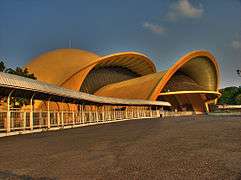
The Golden Snail IMAX theatre at Taman Mini Indonesia Indah
-
Taman Ismail Marzuki, Central Jakarta
Museums

The museums in Jakarta cluster around the Central Jakarta Merdeka Square area, Jakarta Old Town, and Taman Mini Indonesia Indah.
The Jakarta Old Town contains museums that are former institutional buildings of Colonial Batavia. Some of these museums are: Jakarta History Museum (former City Hall of Batavia), Wayang Museum (Puppet Museum) (former Church of Batavia), the Fine Art and Ceramic Museum (former Court House of Justice of Batavia), the Maritime Museum (former Sunda Kelapa warehouse), Bank Indonesia Museum (former Javasche Bank), and Bank Mandiri Museum (former Nederlandsche Handels Maatschappij).
Several museums clustered in central Jakarta around the Merdeka Square area include: National Museum of Indonesia which also known as Gedung Gajah (the Elephant Building), Monumen Nasional (National Monument), Istiqlal Islamic Museum in Istiqlal Mosque, Jakarta, and Jakarta Cathedral Museum on the second floor of Jakarta Cathedral. Also in the central Jakarta area is the Taman Prasasti Museum (former cemetery of Batavia), and Textile Museum in Tanah Abang area.
The recreational area of Taman Mini Indonesia Indah in East Jakarta contains fourteen museums, such as Indonesia Museum, Purna Bhakti Pertiwi Museum, Asmat Museum, Bayt al-Qur'an Islamic Museum, Pusaka (heirloom) Museum, and other science-based museum such as Research & Technology Information Centre, Komodo Indonesian Fauna Museum, Insect Museum, Petrol and Gas Museum, plus the Transportation Museum. Other museums are Satria Mandala Military Museum, Museum Sumpah Pemuda, and Lubang Buaya (Crocodile Well).
Cuisine
The local cuisine of Jakarta is the Betawi cuisine, which reflects various foreign culinary traditions that have influenced the inhabitants of Jakarta for centuries. Betawi cuisine is heavily influenced by Malay-Chinese Peranakan cuisine, neighbouring Sundanese and Javanese cuisine, but also includes Indian, Arabic and European colonial influences. One of the most popular local dishes in Jakarta is Soto Betawi which is made from chunks of beef meat and offals in rich and spicy cow's milk or coconut milk broth. Other popular Betawi dishes includes soto kaki, nasi uduk, kerak telor (spicy omelette), nasi ulam, asinan, ketoprak, rujak and gado-gado Betawi (salad in peanut sauce).
Jakarta has a vast range of food available at hundreds of eating venues and foodcourts located all over the city, from modest street-side warung foodstalls and travelling vendors to high-end fine dining restaurants. Since Jakarta is regarded as the 'melting-pot' and a miniature version of Indonesia, many traditional foods from far-flung regions in Indonesia can be found in Jakarta. For example, traditional Padang restaurants and low-budget Warteg (Warung Tegal) foodstalls are ubiquitous in the capital. Other popular street foods include nasi goreng (fried rice), sate (skewered meats), pecel lele (fried catfish), bakso (meatballs), bakpau (Chinese bun) and siomay (fish dumplings).
Next to a myriad of Indonesian food and regional specialties from all over Indonesia, foreign food is also represented: Chinese, Japanese, Korean, Thai, Indian, American, French, Italian, Vietnamese, Middle Eastern, and modern fusion food can all be found in Jakarta.[63]
Media
Jakarta has numerous newspaper publications, television and radio stations. Several newspapers, including daily, business, and digital papers, are based in Jakarta. Daily newspapers include Kompas, Koran Tempo, Media Indonesia, Republika, Suara Pembaruan, Seputar Indonesia, Suara Karya, Sinar Harapan, Indo Pos, Jurnal Nasional, and Harian Pelita. English language newspapers are also published daily, for example The Jakarta Post and The Jakarta Globe. Chinese language newspapers are Indonesia Shang Bao (印尼商报), Harian Indonesia (印尼星洲日报), and Guo Ji Ri Bao (国际日报). The only Japanese language newspaper is The Daily Jakarta Shimbun (じゃかるた新聞). Jakarta has also the daily newspapers segment such as Pos Kota, Warta Kota, Koran Jakarta, Berita Kota for local readers; Bisnis Indonesia, Investor Daily, Kontan, Harian Neraca (business news) as well as Top Skor and Soccer (sport news).
Jakarta are the headquarters for Indonesia's state media public government stations, TVRI as well as private national television include Metro TV, tvOne, Kompas TV, Trans TV, Trans 7, RCTI, MNC, SCTV, Global TV, Indosiar, ANTV, RTV and NET.. Jakarta has also the local television channels such as Jak TV, O Channel, Elshinta TV, and DAAI TV Indonesia. The city is home to the country's main pay television service. The wide range of cable channels available includes First Media and TelkomVision. Satellite television (DTH) has yet to gain mass acceptance in Jakarta. Prominent DTH entertainment services are Indovision, Okevision, Yes TV, Transvision, and Aora TV. Many TV stations are analogue PAL, but some are now converting to digital signals using DVB-T2 following a government plan to digital television migration.[64]
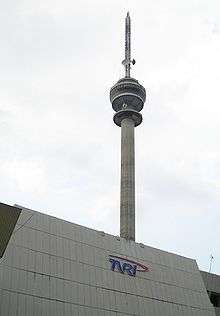
| Channel | Name | Type | Language | Country of Region |
|---|---|---|---|---|
| 22 UHF | INTV | Local | Bahasa Indonesia | |
| 23 UHF | RTV | National | ||
| 25 UHF | Kompas TV | |||
| 26 UHF | CTV Banten | Local | ||
| 27 UHF | NET. | National | ||
| 28 UHF | KTV | Local | ||
| 29 UHF | Trans TV | National | ||
| 30 UHF | iNews TV | |||
| 31 UHF | TVRI Jakarta & Banten | Local | ||
| 33 UHF | O Channel | |||
| 35 UHF | Elshinta TV | |||
| 37 UHF | MNCTV | National | ||
| 39 UHF | TVRI Nasional | |||
| 41 UHF | Indosiar | |||
| 43 UHF | RCTI | |||
| 45 UHF | SCTV | |||
| 47 UHF | antv | |||
| 49 UHF | Trans7 | |||
| 51 UHF | Global TV | |||
| 53 UHF | tvOne | |||
| 55 UHF | JakTV | Local | ||
| 57 UHF | Metro TV | National | ||
| 59 UHF | DAAI TV | Local | ||
| 60 UHF | Radar TV | |||
There are seventy five radio stations in Jakarta, with fifty two broadcasting on the FM band, and twenty three radio stations broadcasting on the AM band.
Economy

Jakarta generated about one-sixth of Indonesian GDP.[65] Jakarta's economy depends highly on service sectors, banking, trading, financial service, and manufacturing. Most of industries in Jakarta include electronics, automotive, chemicals, mechanical engineering and biomedical sciences manufacturing.
The economic growth of Jakarta in 2007 was 6.44% up from 5.95% the previous year, with the growth in the transportation and communication (15.25%), construction (7.81%) and trade, hotel and restaurant sectors (6.88%).[45] In 2007, GRDP (Gross Regional Domestic Product) was Rp. 566 trillion (around $US 56 billion). The largest contributions to GRDP were by finance, ownership and business services (29%); trade, hotel and restaurant sector (20%), and manufacturing industry sector (16%).[45] In 2007, the increase in per capita GRDP of DKI Jakarta inhabitants was 11.6% compared to the previous year[45] Both GRDP by at current market price and GRDP by at 2000 constant price in 2007 for the Municipality of Central Jakarta, which was Rp 146 million and Rp 81 million, was higher than other municipalities in Jakarta.[45] Last data update was on 2014 by end of year Jakarta have a GRDP (Gross Regional Domestic Product) was Rp. 1,761.407 trillion (around USD 148.53 billion) with economic growth above 6% per year since 2009. In 2014, per capita GRDP of DKI Jakarta inhabitants was Rp 174.87 million or USD 14,727.
The cost of living in the city continues to rise. Land is expensive and rents are high. Industrial development and the construction of new housing are usually undertaken on the outskirts, while commerce and banking remain concentrated in the city centre.[66]
Jakarta has a bustling luxury property market. The investment in the property sector, including offices, commercial buildings, new town development, and highrise apartments and hotels grew substantially. Knight Frank, a global real estate consultancy based in London, reported in 2014 that Jakarta offered the highest return on high-end property investment in the world in 2013, citing supply shortage and a sharply depreciated currency as reasons.[67]
Shopping

Jakarta has numerous shopping malls and markets. With a total of 550 hectares, Jakarta has the world's largest shopping mall floor area within a single city.[68] The annual "Jakarta Great Sale" is held every year in June and July to celebrate Jakarta's anniversary, with about 73 participating shopping centres in 2012.[69]
Malls such as Plaza Indonesia, Grand Indonesia Shopping Town, Plaza Senayan, Senayan City and Pacific Place provide luxury brands, while Mall Taman Anggrek, Pondok Indah Mall, Mal Kelapa Gading, Central Park Jakarta and Ciputra World Jakarta have high-street brands such as Topshop, Uniqlo and Zara.[70]

Department stores in Senayan City, Supermall Karawaci and Lippo Mall Kemang Village use the Debenhams brand under licence,[71] while the Japanese Sogo department store has about seven stores in various shopping malls in the city.[72] Seibu flagship store is located in Grand Indonesia Shopping Town, and French luxury department store, Galeries Lafayette opened its doors for the first time in South East Asia in Pacific Place.
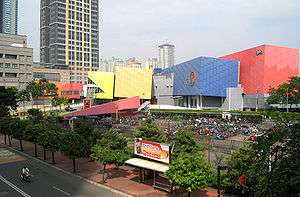
Internationally known luxury brands such as Louis Vuitton, Bulgari, Chanel, Gucci, Christian Louboutin, Balenciaga, and Giorgio Armani can be found in Jakarta's luxury shopping malls.
The Satrio-Casablanca corridor, 3.5-kilometre street is a new shopping belt in Jakarta.[73] Many multistorey shopping centres are located here, such as Kuningan City, Mal Ambassador, Kota Kasablanka, and Lotte Shopping Avenue.
Traditional markets include Blok M, Tanah Abang, Senen, Pasar Baru, Glodok, Mangga Dua, Cempaka Mas, and Jatinegara. In Jakarta there are also markets that sell specific collectable items, such as antique goods in Surabaya Street and gemstones in Rawabening Market.
Infrastructure
Road
A structured road network had been developed in the early 19th century as a part of the Java Great Post Road by former Governor-General Daendels, which connects most major cities throughout Java. During the following decades, the road network was expanded to a great extent, although it could not keep up with the rapidly increasing numbers of motorised vehicles, resulting in highly congested traffic.
A notable feature of Jakarta's present road system is the toll road network. Composed of an inner and outer ring road and five toll roads radiating outwards, the network provides inner as well as outer city connections. The last phase of outer ring road is under construction, but it is largely in use. Six elevated toll roads are in tender progress.
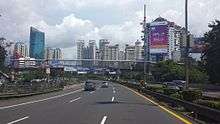
The five radiating toll roads are the:
- Prof. Dr. Sedyatmo Toll Road linking to Soekarno–Hatta International Airport
- Jakarta-Tangerang Toll Road linking to Tangerang and further to Merak in the west
- Jakarta-Serpong Toll Road linking to Serpong
- Jagorawi Toll Road linking to Bogor and Ciawi in the south
- Jakarta-Cikampek Toll Road linking to Bekasi and Cikampek in the east
Throughout the years, several attempts have been made to reduce traffic congestion on Jakarta's main arteries. Implemented solutions include a 'three-in-one' rush-hour law, during which cars with fewer than three passengers are prohibited from driving on the main avenues. Another example is the ban on trucks passing main avenues during the day.[74]
Water supply
Two private companies, PALYJA and Aetra, provide piped water supply in the western and eastern half of Jakarta respectively under 25-year concession contracts signed in 1998. A public asset holding company called PAM Jaya owns the infrastructure. 80% of the water distributed in Jakarta comes through the West Tarum Canal system from Jatiluhur reservoir on the Citarum River 70 km (43 mi) southeast of the city. Water supply had been privatised by government of then President Suharto in 1998 to the French company Suez Environnement and the British company Thames Water International. Both foreign companies subsequently sold their concessions to Indonesian companies. Customer growth in the 7 first years of the concessions had been lower than before, despite substantial inflation-adjusted tariff increases during this period. In 2005 tariffs were frozen, leading the private water companies to cut down on investments.
According to PALYJA in its western half of the concession the service coverage ratio increased substantially from 34% in 1998 to 59% in 2007 and 65% in 2010.[75] According to data by the Jakarta Water Supply Regulatory Body, access in the eastern half of the city served by PTJ increased from about 57% in 1998 to about 67% in 2004, but stagnated after that.[76] However, other sources cite much lower access figures for piped water supply to houses, excluding access provided through public hydrants: One study estimated access as low as 25% in 2005,[77] while another source estimates it to be as low as 18.5% in 2011.[78] Those without access to piped water supply get water mostly from wells that are often salty and polluted with bacteria.
Cityscape

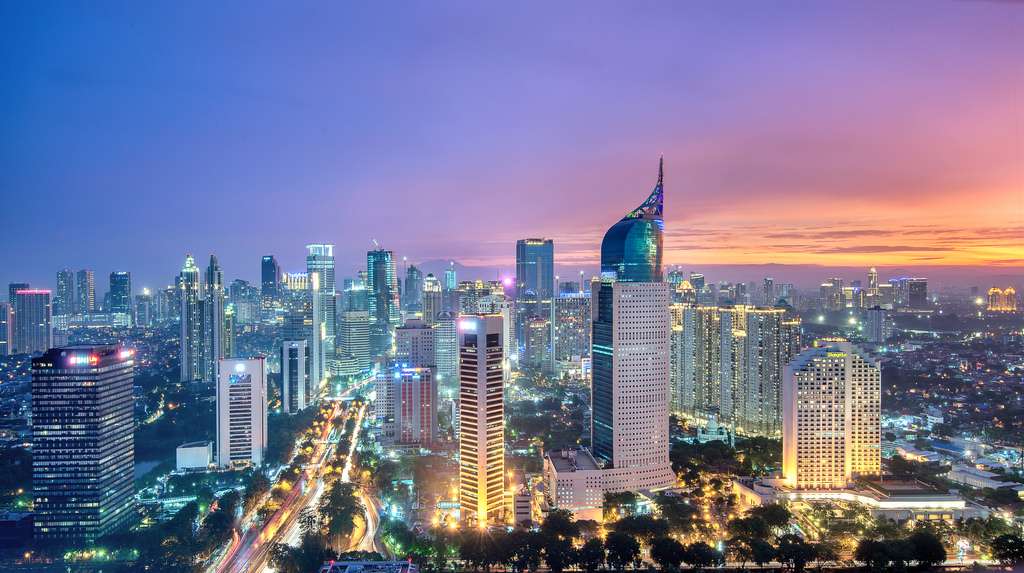
Architecture
Jakarta has architecturally significant buildings in a wide range of styles spanning distinct historical and cultural periods. Architectural styles reflect Malay, Javanese, Arabic, Chinese and Dutch influences.[79] The external influence gives a role in forming the architecture of the Betawi house. The houses were built of nangka wood (Artocarpus integrifolia) and comprised three rooms. The shape of the roof is reminiscent of the traditional Javanese joglo.[22]
Colonial buildings and structures in Jakarta include those that were constructed during the Dutch colonial period of Indonesia. The dominant styles of the Dutch colonial period can be divided into three periods: the Dutch Golden Age (17th to late 18th century), the transitional style period (late 18th century – 19th century), and Dutch modernism (20th century). Dutch colonial architecture in Jakarta is apparent in buildings such as houses or villas, churches, civic buildings, and offices, mostly concentrated in the Jakarta Old Town and Central Jakarta. Architects such as J.C. Schultze and Eduard Cuypers designed some significant buildings in Jakarta. Works of Schultze includes Jakarta Art Building, the Indonesia Supreme Court Building and Ministry of Finance Building, while Cuypers designed Bank Indonesia Museum and Bank Mandiri Museum.
At the early 20th century, most of the buildings in the Jakarta were built in Neo Renaissance style of Europe. By the 1920s, the architectural taste have begun to shift in favor of rationalism and modernist movement, particularly there was increasing art deco architecture. The elite suburbs Menteng, developed during the 1910s, was the city's first attempt at creating an ideal and healthy housing area for the middle class. The original houses had a longitudinal organization of space, as well as overhanging eaves, large windows and open ventilation, all practical features for a tropical climate with a hint of modern art deco.[80] It was developed by the private real estate company N.V. de Bouwploeg, established by P.A.J. Moojen.
After independence, the process of nation building in Indonesia and demolishing the memory of Dutch colonialism was as important as the symbolic building of arterials, monuments, government buildings during the Sukarno era. The National Monument in Jakarta, designed by Sukarno, is Indonesia's beacon nationalism. In the early 1960s, Jakarta with Soviet Union funding providing infrastructure development for highways and super-scale cultural monuments as well as Senayan Sports Stadium. The parliament building features a hyperbolic shaped roof reminiscent of German rationalist and Corbusian design concepts.[81] In 1996, Wisma 46 soars to height of 262 metres with forty eight stories and its nib shaped top celebrates technology and symbolizes stereoscopy.
The urban construction booms have continued in the 21st century and are shaping skylines in Jakarta. According to CTBUH and Emporis,there are now about 800 skyscrapers and 88 of which reaches or exceeds the height of 150 metres in Jakarta & and 26 more still under construction, which puts the city at the top 10 of world rankings.Jakarta is ranked number 8th in the World & 5th in Asia by the number of 150m+ completed building.[82] There are 4 supertall buildings (300m+) that are still under construction. Jakarta has more buildings taller than 500 feet (150 m) than any other Southeast Asia's cities as well as southern hemisphere.
Population
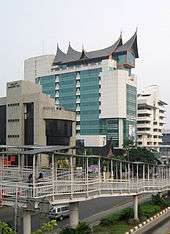
Since 1950, Jakarta has attracted people from all parts of Java and other Indonesian islands. The flood of migrants came to Jakarta for economic reasons as Jakarta offered the hope of employment. The 1961 census showed only 51% of the city's population was actually born in Jakarta.[83] Between 1961 and 1980, the population of Jakarta doubled and during the period 1980-1990, the city's population grew annually by 3.7%.[84]
The 2010 census counted some 9.58 million people, well above all government estimates.[85] According to the Government's Jakarta in Figures document, the population stood at 10,187,595 in 2011 and 9,761,407 in 2012.[86] As per 2014, the population stood at 10,075,310 people.[5] The area of DKI Jakarta is 664 km2, suggesting a population density of 15,174 people/km2 as the ninth largest urban population density in the world.[87] Inwards immigration tended to negate the effect of family planning programs.[45] The population has risen from 4.5 million in 1970 doubled to 9.5 million in 2010, counting only its legal residents. While the population of Greater Jakarta (Jabodetabek Region) has risen from 8.2 million in 1970 jump to 28.5 million in 2010.[88] As per 2014, the population of Greater Jakarta was 30,326,103, accounts for 11% of Indonesia's population.[89] The sex ratio was 102.8 (males per 100 females) in 2010[90] and 101.3 in 2014.[5]
Ethnic groups and religion
|
|
* 2010 Population census |
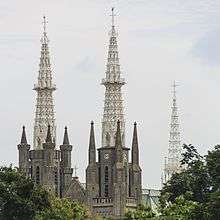
Jakarta is pluralistic and religiously diverse. The city's population in 2000 was 35.16% Javanese, 27.65% Betawi, and 15.27% Sundanese. Betawi people are a creole ethnic group that came from various parts of Indonesia and intermarriage with Chinese, Arabs, and Europeans.[93] Nowadays, most Betawi live in the fringe area of Jakarta and there is hardly any Betawi dominated area in central Jakarta.[94] There has been a significant Chinese community in Jakarta for many centuries. Jakarta is home to the largest population of Chinese on Java island. The Chinese in Jakarta traditionally reside around old urban areas, such as Pinangsia, Pluit and Glodok (Jakarta Chinatown) areas. They also can be found in old chinatowns of Senen and Jatinegara. Officially, they make up 5.53% of the Jakarta population, although this number may be under-reported.[95]
The Sumatran people of the city is very diverse. According to 2010 Census, there were roughly 346,000 Batak, 305,000 Minangkabau and 155,000 Malays. The Batak and Minangkabau living spread throughout the city. The Batak ethnic group has increased in ranking, from eighth in 1930 to fifth in 2000. Toba Batak is the largest sub-ethnic Batak in Jakarta.[96] Beside Chinese, Minangkabau people also as merchants, peddlers, and artisans, in addition to as white collar, doctor, teacher, and journalist.[97][98]
As of 2010 Census the population of Jakarta was 85.36% Muslim, 7.53% Protestant, 3.30% Buddhist, 3.15% Roman Catholic, 0.21% Hindu, and 0.06% Confucianist. The majority of Jakartan are Sunni Muslims. Most of pesantren in Jakarta are affiliated with the traditionalist Nahdlatul Ulama organizations.[99] The modernist organizations mostly catered to a socioeconomic class of educated urban elites and merchant traders. They gave priority to education, social welfare programs and religious propagation activities.[100] Many of Islamic organizations headquarter in Jakarta, such as Nahdlatul Ulama, Indonesian Ulema Council, Muhammadiyah, Jaringan Islam Liberal, and Front Pembela Islam.
There are significant religious minorities, notably Christian and Buddhist. Roman Catholics have a Metropolitan see there, for the Archdiocese of Jakarta, whose province including two suffragans covers Western Java.
Transportation
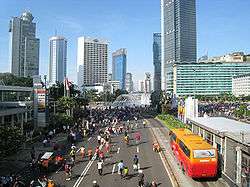
With 28 million people in the metropolitan area, nearly 10 million vehicles in daily use, and limited rapid transit system[101] Jakarta is strained by transportation problems.[102] The city suffers a lack of urban public transport services due to prioritised development of road networks, which were mostly designed to accommodate private vehicles.[103]
Most trips, however, are undertaken by non-motorized transportation (particularly walking) and numerous modes of public or demand-responsive transportation services.[104]
| Transport mode | No. trips ('000) | % share |
|---|---|---|
| walking | 14,073 | 37.7 |
| Angkot (small bus) | 7,818 | 20.9 |
| motorcycle | 4,890 | 13.1 |
| sedan/MPV/SUV | 2,783 | 7.5 |
| medium bus | 2,012 | 5.4 |
| large bus | 1,224 | 3.3 |
| ojek (motorcycle taxi) | 1,073 | 2.9 |
| bicycle | 787 | 2.1 |
| school/company bus | 466 | 1.2 |
| economy train | 434 | 1.2 |
| patas AC (bus) | 422 | 1.1 |
| colt/mini cab | 298 | 0.8 |
| omprengan | 295 | 0.8 |
| bajaj | 217 | 0.6 |
| becak | 202 | 0.5 |
| pick up | 131 | 0.4 |
| taxi | 126 | 0.3 |
| express train | 39 | 0.1 |
| truck | 33 | 0.1 |
| other | 8 | 0.0 |
| total | 37,330 | 100 |
Rail
Long-distance railways and local tram services were first introduced during the Dutch colonial era. While the trams were replaced with buses in the post-colonial era, long-distance railways continued to connect the city to its neighbouring regions as well as cities throughout Java. The surrounding cities of Jakarta are served by KRL Jabodetabek, a commuter rail system which serves commuters both in and around Jakarta. The major rail stations are Gambir, Jakarta Kota, Jatinegara, Pasar Senen, Manggarai, and Tanah Abang. During rush hours, the number of passengers greatly exceeds the system's capacity, and crowding is common.
Air
Soekarno–Hatta International Airport (CGK) is the main airport serving the Greater Jakarta area. The airport is named after the first President of Indonesia, Soekarno, and the first vice-president, Mohammad Hatta. The airport is often called Cengkareng airport or Soetta by Indonesians. The airport's IATA code, CGK, originates from the name of the Cengkareng locality, Tangerang, Banten, although the location of this airport is located outside of the city, it is used as a gate out by the Jakartans and citizen of the surrounding areas, therefore at the main gate of the airport, there is an inscription "Jakarta Airports".[106] According to statictics of Airports Council International,Soekarno–Hatta International Airport was the 9th busiest airport in the world in 2012, 10th in 2013 & 12th in 2014.[107] At present the airport is running over capacity. After renovation & expansion, Terminal 3 serves as a destination terminal and also as a transit terminal with 10 international gates, 20 domestic gates and 10 bus gates. It is slated to be larger than Terminal 3 of Changi Airport , Singapore. T1 and T2 are being revitalised. It is expected that three terminals of SHIA will accommodate 67 million passengers a yea after renovation of all terminals.[108]
A second airport, Halim Perdanakusuma Airport (HLP) serves domestic flight of low cost airline, private and VIP/presidential flights. Other airports in the Jakarta metropolitan area include Pondok Cabe Airport and an airfield on Pulau Panjang, part of the Thousand Island archipelago (Kepulauan Seribu).
Electronic Road Pricing
Due to the city's acute gridlock, the Jakarta administration will implement Electronic Road Pricing (ERP) in 10 districts: Tanah Abang, Menteng, Setiabudi, Tebet, Matraman, Senen, Gambir, Tambora, Sawah Besar and Taman Sari. The projects will initiate once approved by the Finance Ministry.[109] The ERP was planned to be implemented in the three-in-one zone and along Jl. Rasuna Said in Kuningan by the first quarter of 2014, although by September 2016 the plan has not started. Vehicles passing through the ERP areas will be charged Rp 21,072.[110]
Public road transport
Conventional buses
The Kopaja and MetroMini economy minibus systems also provide important services for Jakarta commuters with numerous routes throughout the city. Since January 2013, Jakarta Government allow some Kopaja AC bus to enter TransJakarta bus lanes. Kopaja has integrated with TransJakarta since May,2016 & providing connecting routes from areas outside TransJakarta bus lanes. For the future, Metromini AC bus it is also possible to enter TransJakarta bus lanes to enhance integrated bus rapid transit system.
Traditional transports
In 1966, an estimated 160 thousand pedicabs (becak) operated in the city; as much as 15% of Jakarta's total workforce was engaged in becak driving. In 1971, becak were banned from major roads, and shortly thereafter the government attempted a total ban, which substantially reduced their numbers but did not eliminate them. A campaign to eliminate them succeeded in 1990 and 1991, but during the economic crisis of 1998, some returned amid less effective government attempts to control them.[111]
"Auto rickshaws", called bajaj, provide local transportation in the back streets of some parts of the city. From the early 1940s to 1991 they were a common form of local transportation in the city.
Motorcycle taxi/ojek
Although ojeks are not an official form of public transport, they can be found throughout Indonesia and in Jakarta. They are especially useful when navigating crowded urban roads, narrow alleyways, heavy traffic and cramped locations that larger vehicles cannot reach.
Public transit
Bus rapid transit
The TransJakarta bus rapid transit service (known as Busway) was developed in the context of development reforms (or reformasi) and used Bogota's TransMilenio system as a model.[112] Jakarta's first busway line, from Blok M to Jakarta Kota opened in January 2004 and as of 14 February 2013, twelve out of fifteen corridors are in use. TransJakarta has the world's longest bus rapid transit routes (172 km in length) and has more than 1100 buses in operation.Besides more than 1500 Kopaja A/C buses has integrated with TransJakarta since May,2016.
Electrified rail system
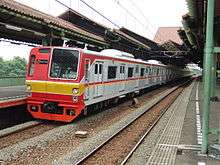
KRL Jabodetabek or commonly known as Commuterline is a commuter rail system which serves commuters in Jakarta, Bogor, Depok, Tangerang, South Tangerang, and Bekasi. The commuter system was started in 2000.[113] The number of passengers in 2014 reached 208 million, rising from 158 million in the previous year.[114] KRL Jabotabek serves all municipalities in Jakarta excluding the Thousand Islands, as well as all neighboring cities and regencies. Currently KRL Jabotabek is the only rail-based transit system in Jakarta, as the mass rapid transit and light rail transit are still under construction.
Mass rapid transit

After a long planning process by the government regarding the development of a mass rapid transit system in Indonesia's capital, the Jakarta Mass Rapid Transit infrastructure is currently under construction, with a north–south line between Kota and Lebak Bulus; and an east–west line, which will connect to the north–south line at Sawah Besar Station. The Jakarta MRT will be a combination of subways and elevated rails. Preparation work started in April 2012,[115] and groundbreaking was done in October 2013, with the first, 15.2 km-long line between Hotel Indonesia and Lebak Bulus scheduled to be operational by 2018, and the north–south line MRT network is scheduled to be operational by 2020. The total length of the network when complete will be approximately 110.8 km.[116][117] The Jakarta city government decided on a rail-based system because of its ability to carry large numbers of people quickly and cheaply.[118] As of 2016, the mass rapid transit system has an investment of nearly US $1.7 billion to ease the capital’s traffic issue in the coming years, including the construction of a subway.[119]
Light rail transit
Previously there had been plans to build a monorail system and part of it was already under construction, but the project stalled in 2004 due to lack of funding. The monorail project was relaunched in 2013 and the groundbreaking was done in October 2013.[120] However the project cancelled in January 2015, due to disagreements between the Jakarta administration and PT Jakarta Monorail over the monorail's route.[121] By mid 2015, this project is finally abandoned by Jakarta Government and being replaced by light rail transit system.
The light rail transit (LRT) project was launched to replace the previously abandoned monorail project.[122] Jakarta Light Rail Transit groundbreaking ceremony was held on 9 September 2015, with the first phase of the construction will connect Cibubur in East Jakarta with Dukuh Atas in downtown Central Jakarta, passing through Cawang intersection. This phase will be 42.1 kilometres long, which include 18 stations, and expected to be operated by the first half of 2018, prior to the 2018 Asian Games.[123]
Waterway
On 6 June 2007, the city administration introduced the Waterway (officially Angkutan Sungai), a new river boat service along the Ciliwung River.[102][124] However, because of the large amount of floating garbage which kept jamming the propeller, it is no longer in service. The varying water levels during the dry and wet seasons were also a contributing factor to the close-down.
Sea
Jakarta's main seaport Tanjung Priok serves many ferry connections to different parts of Indonesia. Port of Tanjung Priok is Indonesia's busiest port, and the 21st busiest port in the world in 2013, handling over 6.59 million TEUs.[125] To boost the port capacity, two-phase "New Tanjung Priok" extension project is currently ongoing. When fully operational in 2023, it will triple existing annual capacity.
The port is also an important employer in the area, with more than 18,000 employees who provide services to more than 18,000 ships every year. The Port of Tanjung Priok has 20 terminals: general cargo, multipurpose terminal, scraps terminal, passenger terminal, dry bulk terminal, liquid bulk terminal, oil terminal, chemicals terminal and three container terminals, 76 berths, a quay length of 16,853 metres, a total storage area of 661,822 m2 and a storage capacity of 401,468 tonnes.[126]
In December 2011, Muara Angke Port was renovated for Rp 130 billion ($14.4 million) in a 3 hectare area. Muara Angke Port would then be used as a public port to Thousand Islands (Indonesia), while Marina Ancol Port would be used as a tourist port.[127]
Tourism
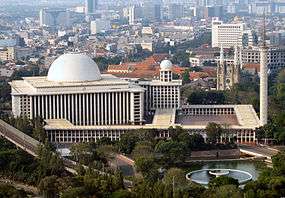
Most of the visitors attracted to Jakarta are domestic tourists from all over Indonesia. As the gateway of Indonesia, Jakarta often serves as the stop-over for foreign visitors on their way to Indonesian popular tourist destinations such as Bali and Yogyakarta. Other than attracted to monuments, landmarks, and museums around Merdeka square and Jakarta Old Town, tourist attractions include Taman Mini Indonesia Indah, Ragunan Zoo, Sunda Kelapa old port and the Ancol Dreamland complex on Jakarta Bay, including Dunia Fantasi (Fantasy World) theme park, Sea World, Atlantis Water Adventure, and Gelanggang Samudra.
Tourism is contributing a growing amount of income to the city. In 2012, the tourism sector contributed 2.6 trillion rupiah (US$268.5 million) to the city's total direct income of 17.83 trillion rupiah, a 17.9 per cent increase over 2011. Tourism stakeholders are expecting greater marketing of the Jakarta as a tourism destination.[128]
In February 2014, the Jakarta Government started providing double-decker bus tours that offers sightseeing in Central Jakarta. The buses' route covers tourist attractions, such as Monas, Istiqlal Mosque, the Cathedral, National Museum, Sarinah, and Plaza Indonesia, as well as Grand Indonesia shopping centres.[129]
Landmarks

Most of Jakarta's landmarks, monuments and statues were built during the Sukarno era beginning in the 1960s, then completed in the Suharto era, while some originated in the colonial Dutch East Indies period. The most famous Jakarta's landmark that become the symbol of the city is the 132 m (433 ft) tall obelisk of National Monument (Monumen Nasional or Monas) right in the centre of Merdeka Square, Jakarta's Central Park. On its southwest corner stands a Mahabharata themed Arjuna Wijaya chariot statue and fountain. Further south through Jalan Thamrin, the main avenue of Jakarta, the Selamat Datang monument stands on the fountain in the centre of Hotel Indonesia roundabout. Other landmarks include the Istiqlal Mosque, the Jakarta Cathedral and Immanuel Church. The former Batavia Stadhuis in Jakarta Old Town is also the city's landmark. The Wisma 46 building in Central Jakarta is currently the second tallest building in Indonesia.
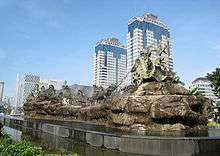
Some of statues and monuments in Jakarta are nationalist, such as the West Irian Liberation monument and Dirgantara statue. Several Indonesian national heroes are commemorated in statues, such as Diponegoro and Kartini statues in Merdeka Square, Sudirman and Thamrin statues located in each respectable avenues, also Sukarno and Hatta statues in Proclamation Monument also on the entrance of Soekarno–Hatta International Airport.
Parks
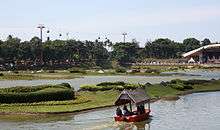
In June 2011, Jakarta had only 10.5% green open space (Ruang Terbuka Hijau) and will be added to 13.94% public green open space. Public parks are included in public green open space. By 2030, the administration also hope there are 16% private green open space.[130]
- Merdeka Square (Medan Merdeka) is an almost 1 km2 field housing the symbol of Jakarta, Monas or Monumen Nasional (National Monument). The square was created by Dutch Governor-General Herman Willem Daendels (1810) and was originally named Koningsplein (King's Square). On 10 January 1993, President Soeharto started the beautification of the square. Several features include a deer park and 33 trees that represent the 33 provinces of Indonesia.[131]
- Lapangan Banteng (Buffalo Field) is located in Central Jakarta near the Istiqlal Mosque, Jakarta, Jakarta Cathedral, and the Jakarta Central Post Office. It is about 4.5 hectares. Initially it was called Waterlooplein and functioned as the ceremonial square during the Netherlands East Indies colonial period. A number of colonial monuments and memorials erected on the square during the colonial period were demolished during the Sukarno era. The most notable monument in the square is the Monumen Pembebasan Irian Barat (Monument of the Liberation of West Irian). During the 1970s and 1980s the park was used as a bus terminal. In 1993 the park was turned into a public space again. It has become a recreation place for people and is occasionally also used as an exhibition place or for other events.[132] The Jakarta Flona (Flora dan Fauna), the flower and decoration plants and pet exhibition, is held in this park around August annually.
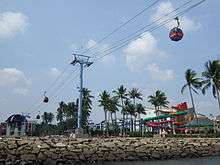
- Taman Mini Indonesia Indah (Miniature Park of Indonesia), in East Jakarta, has 10 mini parks.
- Suropati Park (Taman Suropati) is located in Menteng, Central Jakarta. The park is surrounded by several Dutch colonial buildings. Taman Suropati was known as Burgemeester Bisschopplein during the Dutch colonial time. The park is circular shaped with a surface area of 16,322 m2. There are several modern statues in the park made by artists of the ASEAN countries, which contributes to the nickname of the park "Taman persahabatan seniman ASEAN" ("Park of the ASEAN artists friendship").[133]
- Also located in Menteng are Menteng Park (Taman Menteng) and the Situ Lembang pond. Menteng Park was built on the site of the former Persija football stadium.
Sports

Jakarta was host of the 1962 Asian Games[134] and will host the upcoming 2018 Asian Games, co-hosted by Palembang.[135] Jakarta also hosted the regional-scale Southeast Asian Games in 1979, 1987, 1997, and 2011 where it serves as supporting city for Palembang. Gelora Bung Karno Stadium, located in Central Jakarta, hosted the group stage, quarterfinal and final of 2007 AFC Asian Cup along with Malaysia, Thailand and Vietnam.[136]
Jakarta's most popular home football club is Persija, which plays its matches in their home stadium at Bung Karno Stadium. The home match of Persija often draws its large fanbase - The Jak, usually clad in Persija's typical orange kit – to watch the match in the main stadium. The large number of spectators flocking to the main stadium usually worsen the traffic congestion in Jakarta. Another football team in Jakarta is Persitara who compete in Liga Indonesia Premier Division and play its games in Kamal Muara Stadium. Kamal, North Jakarta.
The biggest stadium in Jakarta is Gelora Bung Karno Stadium, with a capacity of 88,083 seats.[137] The Senayan sports complex has several sport venues, including the Bung Karno football stadium, Madya Stadium, Istora Senayan, aquatic arena, baseball field, basketball court, badminton court, a shooting range, several indoor and outdoor tennis court and a golf driving range. The Senayan complex was built in 1959 to accommodate the Asian Games in 1962. For basketball, the Kelapa Gading Sport Mall in Kelapa Gading, North Jakarta, with a capacity of 7,000 seats, is the home arena of the Indonesian national basketball team.
The Jakarta Car-free Days are held weekly on Sunday on the main avenues of the city, Jalan Sudirman and Jalan Thamrin, from 6 am to 11 am. The briefer Car-Free Day which lasts from only 6 am to 9 am is held on every other Sunday. The event invites local pedestrians to do sports and exercise and have their activities on the streets that are normally full of cars and traffic. Along the road from the Senayan traffic circle on Jalan Sudirman, South Jakarta, to the "Selamat Datang" Monument at the Hotel Indonesia traffic circle on Jalan Thamrin, all the way north to the National Monument in Central Jakarta, cars are cleared out for pedestrians. Morning gymnastics, calisthenics and aerobic exercises, futsal games, jogging, bicycling, skateboarding, badminton, karate, on-street library, and musical performances take over the roads and the main parks in Jakarta.[138]
Jakarta Marathon is said to be the "biggest running event of Indonesia". It is recognised by AIMS and IAAF. First established in 2013 to promote Jakarta as sports tourism city. In 2015 edition of marathon, more than 15,000 runners from 53 countries were participated.[139][140][141][142][143]
Education
Jakarta is home to a number of universities, of which the University of Indonesia (UI) is the largest and oldest tertiary-level educational institution in Indonesia. It is a public institution with campuses in Salemba (central Jakarta) and in Depok to the south of Jakarta.[144] Aside from the University of Indonesia, the three other public universities in Jakarta are: Syarif Hidayatullah State Islamic University Jakarta, the State University of Jakarta (UNJ) and the University of Pembangunan Nasional "Veteran" Jakarta (UPN "Veteran" Jakarta). Some major private universities in Jakarta are: Trisakti University, Mercu Buana University, Tarumanagara University, Atma Jaya University, Pelita Harapan University, Bina Nusantara University, and Pancasila University.
STOVIA (School tot Opleiding van Indische Artsen) was the first high school in Jakarta, established in 1851.[145] As the largest city and the capital, Jakarta houses many students from around Indonesia, many of whom reside in dormitories or home-stay residences. For basic education, there are a variety of primary and secondary schools, tagged with public (national), private (national and bi-lingual national plus) and international schools. Four of the major international schools located in Jakarta are the Gandhi Memorial International School, IPEKA International Christian School, Jakarta Intercultural School and the British School Jakarta. Other international schools include the Jakarta International Korean School, Bina Bangsa School, Jakarta International Multicultural School,[146] Australian International School,[147] New Zealand International School,[148] Singapore International School, and Sekolah Pelita Harapan.[149]
International relations

As the capital city of Indonesia, Jakarta host numbers of embassies of foreign countries that has established diplomatic relations with Indonesia. Jakarta is also serves as the seat of Association of Southeast Asian Nations (ASEAN) Secretariat; numbers of foreign countries has appointed their embassies also serving as the representative and mission for ASEAN, thus making Jakarta as the diplomatic capital of ASEAN.[150]
Jakarta is also a member of the Asian Network of Major Cities 21 and the C40 Cities Climate Leadership Group.
Twin towns – Sister cities
Jakarta signed sister city agreements with other cities, one of them is Casablanca, Morocco's largest city, that have signed sister city agreement on 21 September 1990. To promote friendship between two cities, Jalan Casablanca, a main avenue famous for its shopping and business centres in South Jakarta, was named after Jakarta's Moroccan sister city. Currently there is no street in Casablanca named after Jakarta, however on the other hand in Rabat, Morocco's capital city, an avenue was named after Sukarno, Indonesia's first president, to commemorate his visit in 1960 also as a token of friendship.[151]
Also within sister cities cooperation, Jakarta has established partnership with Rotterdam of the Netherlands, especially on integrated urban water management, including capacity building and knowledge exchange.[152] This cooperation is mainly because Jakarta and Rotterdam are dealing with similar problems; both cities lies in low-lying flat plain prone of flooding. Plus some of their areas lies below sea level, making an urban drainage system involving canals, dams and pumps is vital for both city. Jakarta seeks to learn from Rotterdam's expertise and experiences on water management.
|
|
|
|
See also
In Jakarta born personalities
To 1900
- Wilhelm Homberg (1652-1715), Dutch naturalist
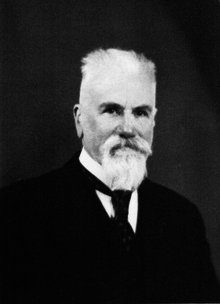
- Arie de Jong (1865-1957), Dutch reformer of plan language Volapük
- Arthur van Schendel (1874-1946), Dutch writer
- Dolf Kessler (1884-1945), Dutch engineer and entrepreneur
- Eddy de Neve (1885-1943), Dutch footballer
- Charles Gairdner (1898-1983), British general
- George Uhlenbeck (1900-1988), American physicist
1901-1950
- Wage Rudolf Supratman (1903-1938), composer
- Reinout Willem van Bemmelen (1904-1983), Dutch geologist
- Hella Haasse (1918-2011), Dutch writer
- Ilse Werner (1921-2005), German actress and singer
- Rob Slotemaker (1929-1979), racing driver
- Tonke Dragt (born 1930), children's book-writer
- Ferry Sonneville (1931-2003), badminton player and -functionary
- Ali Alatas (1932-2008), politician
- F. Springer (1932-2011), Dutch writer and diplomat
- Ben Bot (born 1937), Dutch politician
- Ido Abram (born 1940), Dutch educationalist
- Jeroen Brouwers (born 1940), Dutch journalist, writer and essayist
- Fauzi Bowo (born 1948), politician
From 1951
- Prabowo Subianto (born 1951), general and businessman
- Taco Ockerse (born 1955), pop singer
- Verawaty Wiharjo (born 1957), badminton player
- Rano Karno (born 1960), actor
- Ananda Sukarlan (born 1968), pianist
- Chris John (born 1979), boxer
- Ananda Mikola (born 1980), racing driver
- Jo Novita (born 1980), badminton player
- Barry Likumahuwa (born 1983), jazz musician
- Endang Nursugianti (born 1983), badminton player
- Iko Uwais (born 1983), actor and stuntman
- Alamsyah Yunus (born 1986), badminton player
- Zahir Ali (born 1987), racing driver
- Indra Bagus Ade Chandra (born 1987), badminton player
Notes
- ↑ Pronounced in Indonesian language: [dʒaˈkarta].
References
- 1 2 Suryodiningrat, Meidyatama (22 June 2007). "Jakarta: A city we learn to love but never to like". The Jakarta Post. Archived from the original on 21 February 2008.
- ↑ "Travel Indonesia Guide – How to appreciate the 'Big Durian' Jakarta". Worldstepper-daworldisntenough.blogspot.com. 8 April 2008. Retrieved 27 April 2010.
- ↑ "A Day in J-Town". Jetstar Magazine. April 2012. Retrieved 2 January 2013.
- ↑ "Jokowi submits resignation letter". The Jakarta Post. 11 September 2014. Retrieved 4 November 2016.
- 1 2 3 4 "Data Jumlah Penduduk DKI Jakarta". Jakarta Open Data. Pemerintah Provinsi DKI Jakarta, Dinas Kependudukan dan Catatan Sipil. 2014. Retrieved 5 December 2015.
- ↑ "Jumlah Penduduk Provinsi DKI Jakarta". Dinas Kependudukan dan Catatan Sipil. Archived from the original on 27 December 2013. Retrieved 27 February 2014.
- ↑ http://www.citypopulation.de/php/indonesia-jawa-admin.php
- ↑ Markus Taylor, Tales from the Big Durian, 2009
- ↑ "The World According to GaWC 2012". Globalization and World Cities Study Group and Network (GaWC). Loughborough University. Retrieved 22 December 2015.
- ↑ "Global Metro Monitor | Brookings Institution". Brookings. 2015-01-22. Retrieved 2016-10-08.
- ↑ "Foke lebih yakin lembaga survei asing". 24 April 2012.
- ↑ "Sojourn in the Big Durian". ThingsAsian. Retrieved 14 March 2011.
- ↑ (Dutch) Kampen, N.F. van (1831). Geschiedenis der Nederlanders buiten Europa, p. 291. Haarlem: De Erven François Bohn.
- ↑ (Dutch) "Batavia zoals het weent en lacht", (17 October 1939), Het Nieuws van den Dag voor Nederlandsch-Indië, p. 6
- ↑ Sundakala: cuplikan sejarah Sunda berdasarkan naskah-naskah "Panitia Wangsakerta" Cirebon. Yayasan Pustaka Jaya, Jakarta. 2005.
- ↑ Drs. R. Soekmono (1973). Pengantar Sejarah Kebudayaan Indonesia 2, 2nd ed. Yogyakarta: Penerbit Kanisius. p. 60.
- ↑ Sumber-sumber asli sejarah Jakarta, Jilid I: Dokumen-dokumen sejarah Jakarta sampai dengan akhir abad ke-16. Cipta Loka Caraka. 1999.
- 1 2 "History of Jakarta". BeritaJakarta.
- ↑ Ricklefs, M.C. (1993). A History of Modern Indonesia Since c.1300 (2nd ed.). London: MacMillan. p. 29. ISBN 0-333-57689-6.
- ↑ Heuken, Adolf (2000). Sumber-sumber asli sejarah Jakarta Jilid II: Dokumen-dokumen Sejarah Jakarta dari kedatangan kapal pertama Belanda (1596) sampai dengan tahun 1619 (Authentic sources of History of Jakarta part II: Documents of history of Jakarta from the first arrival of Dutch ship (1596) to year 1619). Jakarta: Yayasan Cipta Loka Caraka.
- 1 2 3 4 Witton, Patrick (2003). Indonesia. Melbourne: Lonely Planet Publications. pp. 138–139. ISBN 1-74059-154-2.
- 1 2 P. Nas, Jakarta-Batavia: Socio-cultural Essays, 2000
- ↑ Menteng: Pelopor Kota Taman, 3 November 2007
- ↑ Colonial Economy and Society, 1870–1940. Source: U.S. Library of Congress.
- ↑ Bakker, K.; Kooy, M.; Shofiani, N. E.; Martijn, E. J. (2008). "Governance Failure: Rethinking the Institutional Dimensions of Urban Water Supply to Poor Households". World Development. 36 (10): 1891. doi:10.1016/j.worlddev.2007.09.015.
- ↑ "Portal Resmi Pemprov DKI Jakarta". www.jakarta.go.id. 22 April 2013. Retrieved 20 January 2014.
- ↑ Kusno, Abidin (2000). Behind the Postcolonial: Architecture, Urban Space and Political Cultures. New York City: Routledge. ISBN 0-415-23615-0.
- ↑ Schoppert, P.; Damais, S. (1997). Java Style. Paris: Didier Millet. ISBN 962-593-232-1.
- ↑ "Why ethnic Chinese are afraid". BBC News. 12 February 1998.
- ↑ "Jakarta". Encyclopædia Britannica Online. Encyclopædia Britannica, Inc. Retrieved 17 September 2007.
- ↑ Douglas, M. (1989). "The Environmental Sustainability of Development. Coordination, Incentives and Political Will in Land Use Planning for the Jakarta Metropolis". Third World Planning Review. 11 (2): 211–238.
- ↑ Douglas, M. (1992). "The Political Economy of Urban Poverty and Environmental Management in Asia: Access, Empowerment and Community-based Alternatives". Environment and Urbanization. 4 (2): 9–32. doi:10.1177/095624789200400203.
- ↑ Turner, Peter (1997). Java (1st edition). Melbourne: Lonely Planet. p. 315. ISBN 0-86442-314-4.
- ↑ Sajor, Edsel E. (2003). "Globalization and the Urban Property Boom in Metro Cebu, Philippines". Development and Change. 34 (4): 713–742. doi:10.1111/1467-7660.00325.
- ↑ Friend, Theodore (2003). Indonesian Destinies. Harvard University Press. p. 329. ISBN 0-674-01137-6.
- ↑ Wages of Hatred. Michael Shari. Business Week.
- ↑ Friend, T. (2003). Indonesian Destinies. Harvard University Press. ISBN 0-674-01137-6.
- ↑ Minggu, 19 Juli 2009 – 13:16 WIB. "Daftar Serangan Bom di Jakarta". Poskota. Retrieved 27 April 2010.
- ↑ "Central Jakarta Profile". The City Jakarta Administration. Jakarta.go.id. Retrieved 19 December 2009.
- ↑ "West Jakarta Profile". The City Jakarta Administration. Jakarta.go.id. Retrieved 24 February 2010.
- ↑ "South Jakarta Profile". The City Jakarta Administration. Jakarta.go.id. Retrieved 19 December 2009.
- ↑ "East Jakarta Profile". The City Jakarta Administration. Jakarta.go.id. Retrieved 19 December 2009.
- ↑ "North Jakarta Profile". The City Jakarta Administration. Jakarta.go.id. Retrieved 19 December 2009.
- ↑ ""Thousand Island" Profile". The City Jakarta Administration. Jakarta.go.id. Retrieved 19 December 2009.
- 1 2 3 4 5 6 Jakarta in Figures. Statistics DKI Jakarta Provincial Office, Jakarta. 2008.
- ↑ "Jakarta holds historic election". BBC News. BBC. 8 August 2007.
- ↑ Sita W. Dewi, 'Council approves city budget for 2013, higher than proposed', The Jakarta Post, 29 January 2013.
- ↑ 'Taxpayer money for the city', The Jakarta Post, 16 July 2011.
- ↑ Sita W. Dewi, 'Jokowi spends less, provides more than Foke, say observers', The Jakarta Post, 9 December 2013.
- ↑ Post, The Jakarta. "Editorial: Regional budgets underspent". The Jakarta Post. Retrieved 2016-10-08.
- ↑ Jakarta in Figures
- ↑ Based on Governor Decree in 2007, No. 171. taken from Statistics DKI Jakarta Provincial Office, Jakarta in Figures, 2008, BPS, Province of DKI Jakarta
- ↑ "Elevation of Jakarta,Indonesia Elevation Map, Topo, Contour". Flood Map. Retrieved 30 November 2016.
- ↑ "Map of Jakarta, Java, Indonesia". ClimaTemps.com. Retrieved 30 November 2016.
- ↑ "The Tides: Efforts Never End to Repel an Invading Sea". Jakarta Globe. Retrieved 15 November 2015.
- ↑ Dutch to study new dike for Jakarta Bay | The Jakarta Post
- ↑ "New Ciliwung River Dams Planned as Jakarta Struggles With Latest Floods". 20 January 2014.
- ↑ "Jatinegara residents complain about underground tunnel project". Retrieved 24 April 2015.
- ↑ "INDONESIA - HALIM PERDANAKUS". Centro de Investigaciones Fitosociológicas. Retrieved 26 June 2016.
- ↑ "STATIONSNUMMER 96745" (PDF). Ministry of Energy, Utilities and Climate. Archived from the original on 16 January 2013. Retrieved 26 June 2016.
- ↑ The Betawi – due to their diverse origins – play a major role concerning ethnic and national identity in contemporary Jakarta; see Knörr, Jacqueline: Kreolität und postkoloniale Gesellschaft. Integration und Differenzierung in Jakarta, Campus Verlag: Frankfurt a.M. & New York, 2007, ISBN 978-3-593-38344-6
- ↑ Knörr, Jacqueline (2007). Kreolität und postkoloniale Gesellschaft. Integration und Differenzierung in Jakarta. Frankfurt: Campus Verlag. ISBN 978-3-593-38344-6.
- ↑ A Yahoo! Contributor, 17 May 2009. "Haveli Indian Cuisine & Bar, Jakarta, Indonesia – Yahoo! Travel". Travel.yahoo.com. Retrieved 27 April 2010.
- ↑ TV Digital Indonesia – Siaran TV Digital
- ↑ Yukon Huang, Alessandro Magnoli Bocchi; Reshaping Economic Geography in East Asia, 2009
- ↑ http://www.britannica.com Jakarta
- ↑ Josua Gantan (13 February 2013). "Jakarta: The Luxury Property Capital of the World", The Jakarta Globe, Retrieved 27 May 2014
- ↑ "Jakarta, Kota dengan Lahan Mal Terluas di Dunia". October 22, 2015.
- ↑ "Jakarta Great Sale declared roaring success". The Jakarta Post. 15 July 2012. Retrieved 21 July 2012..
- ↑ "Jakarta Malls and Shopping Centers – luxury shopping in Jakarta, Indonesia". Expat.or.id. Retrieved 27 April 2010.
- ↑ "International Franchise Stores". Debenhams plc. 2013. Retrieved 4 June 2016.
- ↑ http://sogo.co.id/stores/
- ↑ Kompas.com Jalan Satrio Dijadikan "Shopping Belt" Jakarta
- ↑ "Urai Kemacetan, PR Terbesar Kapolda Metro".
- ↑ PALYJA. "Key Figures". Archived from the original on 18 January 2012. Retrieved 20 November 2011.
- ↑ Iwan, Renalia (November 2008). "Ten Years of Public Private Partnership in Jakarta Drinking Water Service (1998–2007) Eastern Jakarta Drinking Water Service by Thames PAM Jaya" (PDF). Master Thesis. School of Geography, Environment and Earth Sciences Victoria University of Wellington, New Zealand. pp. 42–44. Retrieved 20 November 2011.
- ↑ Karen Bakker; Michelle Kooy; Nur Endah Shofiani; Ernst-Jan Martijn (2006). "Disconnected: Poverty, Water Supply and Development in Jakarta, Indonesia" (PDF). Human Development Report 2006, Occasional Paper. UNDP. Retrieved 20 November 2011.
quoting a Personal Communication from Kris Tutuko, Technical Director PAM JAYA, Jakarta, Indonesia
- ↑ KRuHA People's coalition for the rights to water (7 June 2011). "Poor Water Service, Most of Jakarta People Threatened by E-Coli". Retrieved 20 November 2011.
- ↑ Jacqueline Knorr, Creole Identity in Postcolonial Indonesia, 2014
- ↑ http://www.thejakartapost.com Building on the Past
- ↑ Ryan Bishop, John Phillips, Wei Wei Yeo; Postcolonial Urbanism: Southeast Asian Cities and Global Processes, 2003
- ↑ "CTBUH Tall Building Database". The Skyscraper Center. Retrieved 2015-10-27.
- ↑ Cybriwsky and Ford, City profile - Jakarta, 2001
- ↑ archive.unu.edu Jabotabek, the Jakarta metropolitan area
- ↑ "After census city plans for 9.6 million". Jakarta Pos
- ↑ Jakarta in Figures, page 83
- ↑ BRT – CASE STUDY 5 – Annex 5 Case Studies and Lessons – Module 2: Bus Rapid Transit (BRT): Toolkit for Feasibility Studies. Sti-india-uttoolkit.adb.org. Retrieved 12 June 2011.
- ↑ Puslitbang Ekonomi dan Pembangunan, Perubahan Pemanfaatan Tanah di Jabotabek, Jakarta: Lembaga Ilmu Pengetahuan Indonesia, 1998
- ↑ http://www.thejakartapost.com Population growth of Greater Jakarta and its impact
- ↑ http://www.knoema.com Jakarta (Special City District) - Sex Ratio
- ↑ Indonesia's Population: Ethnicity and Religion in a Changing Political Landscape. Institute of Southeast Asian Studies. 2003. ISBN 9812302123
- ↑ Population of Indonesia by province 2010. Statistics Indonesia
- ↑ Rogelio Sáenz, David G. Embrick, Néstor P. Rodríguez; The International Handbook of the Demography of Race and Ethnicity, 2015
- ↑ Alessandra Iyer, Indonesian Performing Arts: Tradition and Transition, 2001
- ↑ Johnston, Tim (3 March 2005). "Chinese diaspora: Indonesia". BBC News. BBC.
- ↑ Anthony Reid, Imperial Alchemy: Nationalism and Political Identity in Southeast Asia, 2010
- ↑ Board of Editors, Contributions to Southeast Asian Ethnography, 1987
- ↑ Mochtar Naim, Merantau: Causes and Effects of Minangkabau Voluntary Migration, 1971
- ↑ Pemerintah Provinsi Daerah Khusus Ibukota Jakarta, Ensiklopedi Jakarta: Culture & Heritage, Vol. 1, Dinas Kebudayaan dan Permuseuman, 2005
- ↑ Donald Porter, Managing Politics and Islam in Indonesia, 2002
- ↑ Joe Cochrane (4 August 2013). "Hours to Go, Just to Get to Work: Indonesians Cope With Infuriating Traffic and Inefficient Public Transit". The New York Times. Retrieved 5 August 2013.
- 1 2 Williamson, Lucy (6 June 2007). "Jakarta begins river boat service". BBC News.
- ↑ "Transportation Issues and Future Condition in Tokyo, Jakarta, Manila and Hiroshima" (PDF). Retrieved 11 May 2010.
- ↑ [Technical Report Table 1.3.2 of the Study on Integrated Transportation Master Plan for Jabodetabek (SITRAMP), undertaken by Pacific Consultants International and ALMEC Corporation on behalf of the Indonesian National Development Planning Agency (BAPPENAS) and the Japan International Cooperation Agency (JICA), 2004],
- ↑ Technical Report Tables 1.3.2 of the Study on Integrated Transportation Master Plan for Jabodetabek (SITRAMP), undertaken by Pacific Consultants International and ALMEC Corporation on behalf of the Indonesian National Development Planning Agency (BAPPENAS) and the Japan International Cooperation Agency (JICA), 2004.
- ↑ "Tol Bandara". Poskotanews=12 January 2012.
- ↑ "Year to date" www.aci.aero
- ↑ Pingkan Elita Dundu (17 November 2014). "Agar Penumpang Lebih Aman dan Nyaman di Bandara Soekarno-HattaYYY".
- ↑ "10 districts prepared for electronic road pricing policy trial run in Jakarta". 2 September 2011.
- ↑ "City teams up with police for ERP". The Jakarta Post. 19 October 2013. Retrieved 10 December 2013.
- ↑ Azuma, Yoshifumi (2003). Urban peasants: beca drivers in Jakarta. Jakarta: Pustaka Sinar Harapan.
- ↑ "Lo, Ria Hutabarat (2010). "The City as a Mirror: Transport, Land Use and Social Change in Jakarta" ''Urban Studies'' 47(3): 529–555". Usj.sagepub.com. Retrieved 14 March 2011.
- ↑ "Sudibya (2010). "Development of Restructuring of PT Kereta Api - Jabotabek Division"" (PDF). Usj.sagepub.com. Retrieved 14 March 2011.
- ↑ "Number of Train Passengers, 2006 - 2014". Statistics Indonesia. Badan Pusat Statistik. Retrieved 10 March 2015.
- ↑ Preparation work for MRT begins | The Jakarta Post
- ↑ "MRT Jakarta". www.jakartamrt.co.id. Retrieved 2016-10-05.
- ↑ "City launches two busway routes". The Jakarta Post. Retrieved 14 March 2011.
- ↑ "Rail-based Transportation, Main Component of Metropolitan City". Berita Jakarta. Retrieved 16 June 2011.
- ↑ Post, The Jakarta. "MRT Jakarta: Digging the city". The Jakarta Post. Retrieved 2016-10-08.
- ↑ Monorel Bisa Dinikmati Warga DKI Tahun 2016 (16 October 2013). "Monorail can be enjoyed by Jakartans in 2016" (in Indonesian). Kompas.com. Retrieved 16 October 2013.
- ↑ "Jakarta to cancel monorail construction". The Jakarta Post. 13 January 2015. Retrieved 10 March 2015.
- ↑ "Ahok confirms cancellation of monorail project". The Jakarta Post. Jakarta. 10 September 2015. Retrieved 21 September 2015.
- ↑ Raditya Margi (9 September 2015). "Jokowi kicks off LRT construction". The Jakarta Post. Jakarta. Retrieved 21 September 2015.
- ↑ "Jakarta gets its first klong taxis". Bangkok Post. The Post Publishing Public Co.
- ↑ http://www.worldshipping.org Top 50 world container ports
- ↑ Port of Jakarta facilities
- ↑ "Pelabuhan Muara Angke Siap Digunakan". Retrieved 9 December 2011.
- ↑ "Jakarta builds for the future". TTGmice. Retrieved 15 April 2013.
- ↑ http://www.thejakartapost.com Lukewarm response on first day of double-decker buses
- ↑ Ruang Terbuka Hijau Terus Ditambah | Poskotanews.com
- ↑ "Taman Medan Merdeka (Indonesian)". Dartmouth deskominfomas. Jakarta.go.id. Archived from the original on 23 May 2010.
- ↑ "Taman Lapangan Banteng (Indonesian)". deskominfomas. Jakarta.go.id. Archived from the original on 24 May 2010.
- ↑ "Taman Suropati (Indonesian)". deskominfomas. Jakarta.go.id. Archived from the original on 23 May 2010.
- ↑ "Olympic Council of Asia: Games". Ocasia.org. Retrieved 27 September 2014.
- ↑ "Olympic Council of Asia: Games". Ocasia.org. Retrieved 27 September 2014.
- ↑ "Asian Cup 2007 Host nations". 11 September 2007.
- ↑ "Football stadiums of the world – Stadiums in Indonesia". Fussballtempel.net. Retrieved 27 April 2010.
- ↑ "Car-Free Day reduces air pollution: Tests". 25 June 2008.
- ↑ "Thousands of runners to join Jakarta Marathon 2015 on Sunday". The Jakarta Post. 2015-10-23. Retrieved 2015-11-19.
- ↑ "Here are the New Routes for Jakarta Marathon 2015 | GIVnews.com - Indonesian Perspective to Global Audience". Globalindonesianvoices.com. 2015-09-26. Retrieved 2015-11-19.
- ↑ "Wonderful Indonesia - Jakarta Marathon 2014 : Indonesia's Biggest Running Event". Indonesia.travel. Retrieved 2015-11-19.
- ↑ "AIMS - Calendar of Races". Aimsworldrunning.org. Retrieved 2015-11-19.
- ↑ "IAAF Approves Jakarta Marathon's Route | Metro | Tempo.Co :: Indonesian News Portal". En.tempo.co. 2013-10-28. Retrieved 2015-11-19.
- ↑ "Profile | Universitas Indonesia". Ui.ac.id. Retrieved 27 April 2010.
- ↑ "Print Artikel". Majalah-farmacia.com. Retrieved 27 April 2010.
- ↑ "Jakarta International Multicultural School". Jimsch.org. Retrieved 14 March 2011.
- ↑ "Welcome to Australian International School Indonesia". Ais-indonesia.com. Retrieved 14 March 2011.
- ↑ "Welcome to New Zealand International School". Nzis.net. Retrieved 14 March 2011.
- ↑ "Sekolah Pelita Harapan". Sph.edu. Retrieved 14 March 2011.
- ↑ "Jakarta is Affirmed to be a Diplomatic Capital City". Association of Southeast Asian Nations.
- 1 2 Veeramalla Anjaiah (30 July 2009). "Morocco seeks to boost business ties with RI: Envoy". The Jakarta Post. Retrieved 14 June 2013.
- 1 2 "Jakarta and Rotterdam strengthen ties on urban water management". Neso Indonesia. 16 September 2014.
- ↑ "Sister Cities (States) of Tokyo - Tokyo Metropolitan Government". Retrieved 2010-05-09.
- ↑ "Sister Cities". Beijing Municipal Government. Retrieved 23 June 2009.
- 1 2 "Weekly 5: Jakarta's sister cities". The Jakarta Post. 6 March 2015.
- 1 2 3 4 5 6 7 8 "KONI DKI Jalin Kerja Sama "Sister City" dengan 21 Kota Dunia". Beruta Satu (in Indonesian). 26 June 2014.
- ↑ Seul Metropolitan Government. "International Cooperation: Sister Cities". Archived from the original on 10 December 2007.
- ↑ "International Cooperation: Sister Cities". Seoul Metropolitan Government. www.seoul.go.kr. Archived from the original on 10 December 2007. Retrieved 26 January 2008.
- ↑ "Seoul -Sister Cities [via WayBackMachine]". Seoul Metropolitan Government (archived 2012-04-25). Retrieved 23 August 2013.
- 1 2 3 4 5 6 7 8 LB Ciputri Hutabarat (12 February 2016). "Ahok Berencana Kunjungi Pyongyang". MetroTV News (in Indonesian).
- ↑ "About Manila: Sister Cities". City of Manila. Retrieved 24 November 2016.
- ↑ "ROTTERDAM: EEN STERKINTERNATIONAAL MERK" (PDF) (PDF) (in Dutch). Rotterdam, The Netherlands: City of Rotterdam. 2008. p. 37. Retrieved 20 March 2015.
- ↑ "Berlin – City Partnerships". Der Regierende Bürgermeister Berlin. Archived from the original on 21 May 2013. Retrieved 17 September 2013.
- ↑ "JAKARTA BERLIN ART FESTIVAL 2014: BRINGING JAKARTA'S MULTICULTURALISM TO BERLIN". Indonesian Embassy in Berlin. 14 November 2014.
- ↑ "The Jakarta Post - Hungarian envoy builds new links with RI". The Jakarta Post.
- ↑ "DKI-Kairo Jalin Kerjasama Sister City". Jakarta.go.id (in Indonesian). 28 January 2016.
- ↑ Aulia Bintang Pratama (26 January 2016). "Ahok Kesulitan Kunjungi 21 "Sister City" Jakarta". CNN Indonesia (in Indonesian).
- ↑ "Sister Cities of Los Angeles". Retrieved 18 December 2009.
- ↑ "Jakarta - Indonesia". LOS ANGELES - JAKARTA SISTER CITY.
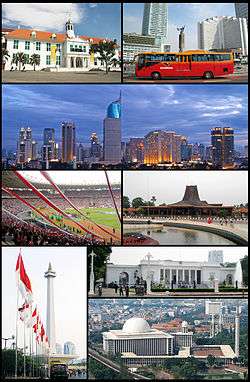
.svg.png)

